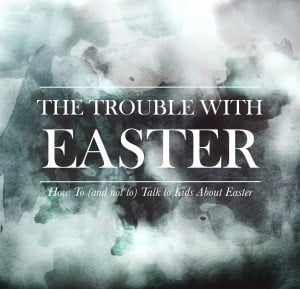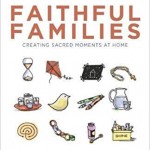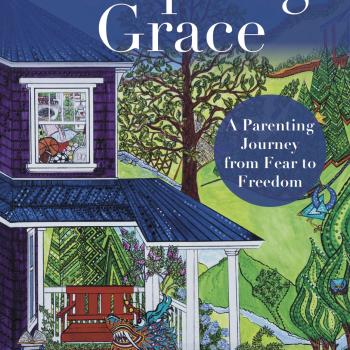
Public execution! Child Sacrifice! Rising from the dead!
Just the kinds of stories you want to tell your kid(s), right? Yeah…me either.
As a Children’s Pastor in a Progressive Christian church, Easter is…well…it’s rough. For me, anyway. I am responsible for children birth-5th Grade and teaching this central Christian story to kids is one of my biggest challenges. No matter what I do with the Easter story, someone is likely to be upset. If I tell it flat-out, I not only go against my ethos in regard to nurturing children’s spirituality but I’d also be confusing boatloads of kids and the message of my ministry as a whole. If I don’t tell it at all, I’ll certainly have folks (more outside the church than within) wondering what sort of heretical witchcraft I’m having the kids do instead (because abandoning a central narrative of our faith would obviously mean I’ve turned my children’s ministry into Hogwarts. Though, now that I think about it…that could be fun.) If I kind of tell the story, you know, reframe it, leave the icky stuff out, “simplify it” for the kids – the story becomes hollow (because it’s not meant to be a moral-of-the-story kind of narrative) and I would argue this jeopardizes the integrity of the text.
That said, there are things I know I DON’T want to teach:
“Jesus died for you/your sins.” While I realize that statement won’t psychologically damage every kid, if it damages ONE, it’s not worth using. Period. To that end, I can list hundreds of people for whom this sentiment was harmful. We have to find better words and be VERY intentional with our language. And the reality is, Jesus didn’t die specifically for your kid. I know that’s a bit blunt but technically – Jesus died publicly and grotesquely because he was a political and religious threat to those in power. Philosophically/Theologically – I believe Jesus submitted to the judicial system of the day because he felt it was the right thing to do and perhaps the most powerful way to communicate the notion that God’s presence follows us – even unto death. All that to say, using language of “Jesus died for you” is misleading, at best.
That God killed Jesus/wanted Jesus to die/intended for Jesus to die as the primary purpose of his life. To attempt to teach the concept of a loving God while also delivering this narrative (along with many other Biblical narratives) is confusing and jarring. This also makes the concept of “following Jesus” much more ominous and threatening than it should be.
Jesus died to save them from God’s judgement/hell. This suggests that these children exist in a way that is displeasing or unsatisfactory to God, which further suggests that God is a being sitting on some shiny throne literally evaluating every individual life from afar, casting judgement and glaring in disdain. There is nothing inherent to these children’s humanity from which they need to be saved. Therefore, an atonement theology of inborn corruption in need of redemption has no place in a conversation with kids about Easter. (Of course, when you don’t believe in a literal, eternally-flaming hell, this point is easier to deal with.)
Coming back from the dead is something you can expect to happen. While there is much beauty to be mined from the resurrection narrative (I’ll touch on this later), I don’t think it’s helpful or healthy to suggest that resurrection is a present-day reality that our children can hope/wish for in their own lives. This idea, I believe, hinders the grief process and doesn’t help them to effectively process death. It’s important for our children to learn to face loss gracefully, accepting the reality of that loss while being held as they grieve.
SO WHAT ON EARTH DO WE DO WITH EASTER?!
One thing to bear in mind is this: the point of the Easter story isn’t whether or not Jesus LITERALLY rose from the dead. We’re missing the point if we’re fighting over the historical accuracy of a bodily resurrection. There’s SO MUCH MORE depth to the story than that and we would do well to dig in for ourselves – we’ll likely find lots more way to discuss it with our children when we do.
Below are some further thoughts on what I take away from this story and perhaps some ways you can talk about this narrative with your own children:
The way of Jesus is one of honesty, bravery, love, and kindness. Jesus set an example that we can follow. Not by mimicking his actions (aka you don’t have to be publicly executed to follow Jesus), but by walking the same path he walked, loving God, self and others always.
You could say, “Jesus was courageous and honest and we can follow in the way of Jesus by being courageous and honest, too. He also reminded everyone that they are loved and that they can help others know they’re loved, too. How can you follow in the way of Jesus – a way of honest, courage, love, and kindness?”
New life often pops up unexpectedly. It brings with it hope and comfort knowing that our world sustains us and that what has gone away is never truly gone. This is what we experience when we smell something familiar and are reminded of a departed loved one. Things come back around, though not always in the way we expect them to.
Say: “When Jesus died, his friends were so sad and so confused – everyone thought he was going to be with them forever and would eventually become a great ruler. But that didn’t happen. Our story tells us that a few days after Jesus died, his friends saw him again. Then they were even MORE scared and confused! I would be, too! And they heard Jesus tell them, ‘I can’t be with you forever. But you’re going to be okay and in fact, you’re going to do AMAZING things in this world! Keep going and keep loving.’ It’s not what they expected, but they felt encouraged and loved.”
Our stories often reflect what happens in our world. This year, I’m focusing on “Spring” with my 3 yr olds through 1st graders. Children’s bodies and behaviors often naturally reflect what the earth is doing. They are in tune with the seasons and are beginning to see “new life” pop up all around them as leaves reappear on trees, flowers bloom, and grass gets greener and begins to grow. The idea of new life is certainly a theme plucked from the Easter story. but we can choose to communicate it without using a confusing plot of betrayal, public execution, a vengeful God, and the walking dead.
Ask: “How can we observe our world and find God in what we see around us?”
Our actions are our own. Even when our friends don’t understand, we do what’s right.
Say: “Jesus’s friends didn’t understand why he didn’t fight back. But Jesus did was he felt was right, even when his friends didn’t understand.”
Even in the most difficult times, we can know that we’re loved. We all bear God’s image so God is never far from us.
Ask> “When have you felt sad or afraid? What can you do to remember that God is with you always?”
Stories don’t have to be factual to speak truth. And it’s okay to question a literal resurrection – questions are how we learn. And there is always truth to be found in curiosity, even if the answers don’t turn out to be what you thought they’d be.
Ask: “Do you know of a story like a myth or fable that teaches a great lesson but isn’t filled with facts? How might the Easter story work the same way and what do you think we can learn from it?”
Enjoy this season of rebirth and new life with your kids. I’m experiencing that sentiment more deeply this year than ever in my life. There truly is something divine about the turning of the seasons and the life that comes during this time of year and it’s certainly no coincidence that we celebrate this holiday during the springtime. To everything there is a season – and this is the season of life. Breathe it in. Explore. Create. Play. All we have is this life – let’s live it well, even unto death.












